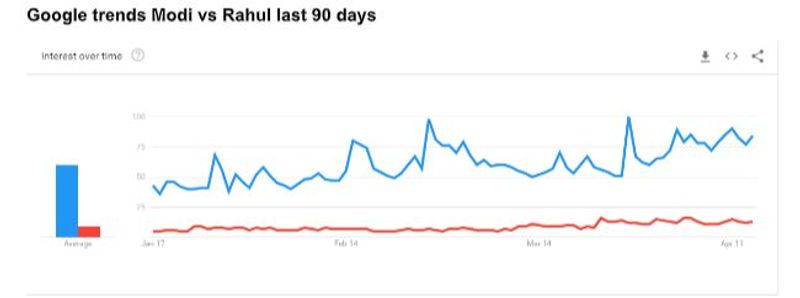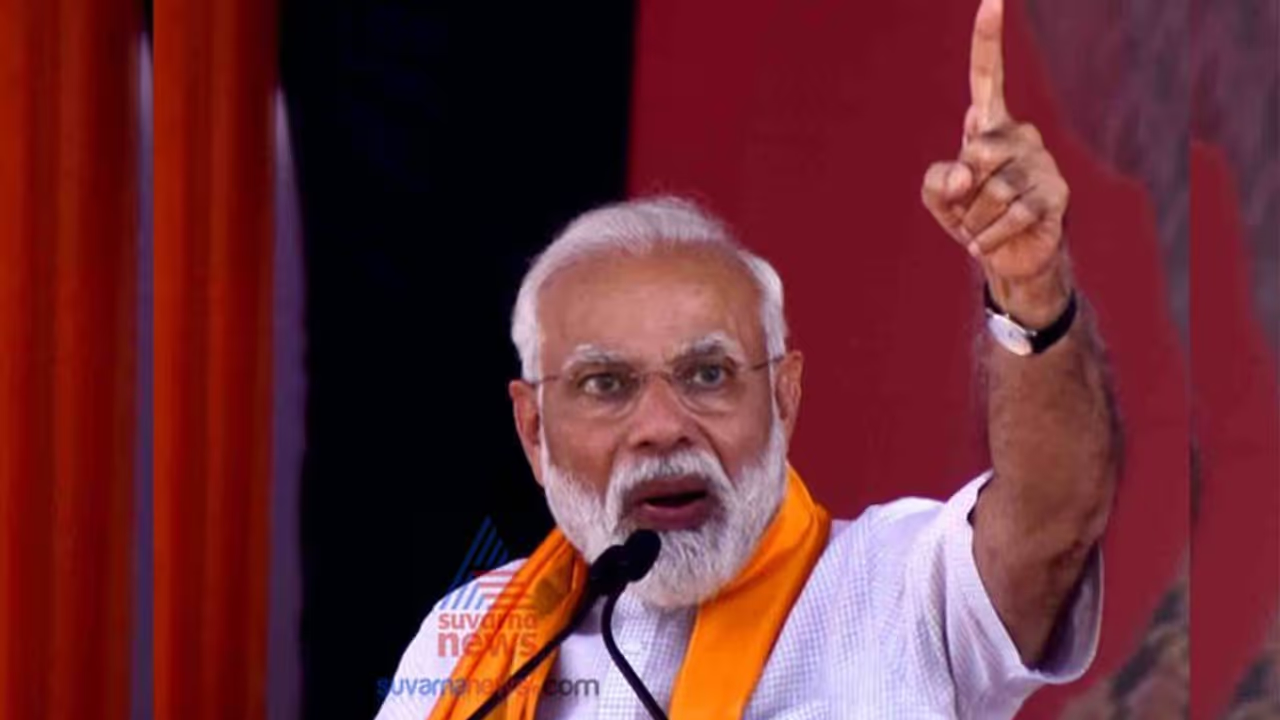In a presidential-style contest, Rahul is no match for Modi. Even the Google trends of the past 90 days show that Modi enjoys a significant lead over Rahul in the keyword search
Citizens have voted in three phases of the Lok Sabha election of 2019 so far to elect their representatives in Parliament. While BJP is harping on nationalism, Congress hopes its NYAY would help garner votes of the poor and oppressed sections of society. Prime Minister Narendra Modi is reaching out to every nook and corner of the country and running a spirited campaign taking on the ‘mahamilavat’ gang — the term he uses to refer to the opposition’s tentative grand alliance or mahagathbandhan.
He is reinforcing the point in every rally that India, at this crucial juncture in history, cannot afford a khichdi (mixed) government. This election is all about Modi not only for the BJP but also for the Congress and other opposition parties. For the BJP, it is crystal clear that Modi is the biggest star campaigner and the greatest draw at the hustings.
In 2014, 27% of people voted for the BJP only because Modi was the PM candidate. In the end, this proved to be the main difference between the BJP and Congress.
The BJP received around five crore votes due to the Modi factor alone, and this helped it score a fabulous victory. While the BJP secured a total of 17 crore votes, the Congress could garner roughly 12 crore votes in the 2014 Lok Sabha election. A majority of first-time voters pressed the button beside the lotus symbol because of the investment — an economy-friendly image of Modi.

The BJP campaign centres around Modi. “Modi Hai to Mumkin Hai”, “Phir Ek Baar Modi Sarkar” and “Main Bhi Chowkidar” campaigns have been a huge success. So much so that Rahul Gandhi and other opposition leaders have been talking only about Modi in their election speeches. Modi is this, Modi is that; he didn’t do this, he didn’t do that, is all we are hearing from them, suggesting they have some form of Modiphobia.
People want to know about the policies and programmes of the opposition. They are bored with their continuous rants against Modi. That ‘Modi has failed’ is their constant refrain but they do not recall their failures when they were in government.
Congress hasn’t learnt from its mistakes in Gujarat. The more you attack Modi, the stronger he emerges because the people of India are with him.
They have seen enormous progress in the five years of Modi rule. It all boils down to 55 years versus 55 months.
So much is the fear of Modi that neither the Congress nor the rest of the opposition have officially announced their PM candidate. Yes, Rahul is not the official PM candidate of Congress. That’s because he fears he stands no chance against Modi.
In a presidential-style contest, Rahul is no match for Modi. Even the Google trends of the past 90 days show that Modi enjoys a significant lead over Rahul in the keyword search. This is a good way to gauge public mood. Modi’s decisive actions against terrorism have given a fillip to his ratings and created a Modi Wave 2.0. While Modi’s interest overtime score is 60, Rahul’s is 85% lower at 9.

The numbers represent search interest relative to the highest point on the chart for a given region and time. A value of 100 is the peak popularity for any term. A value of 50 means that the term is half as popular. A score of 0 means there was not enough data for this term.
Indian elections are acquiring the presidential style of the United States more and more.
In a Lok Sabha election, many voters compare the leadership aspects of the Prime Ministerial candidates of parties before voting. The BJP has the clear leadership of Modi; the Congress has not made an announcement, but Rahul is the most likely candidate. But who is the candidate of the mahagathbandhan? They have more prime ministerial candidates than the number of regional parties that make the alliance.
Mamata Banerjee, Mayawati, N Chandrababu Naidu, Naveen Patnaik, Akhilesh Yadav and everybody else nurse PM ambitions. How can parties that may not even win 40 seats dream of leading a government in India? All of them are waiting for their Deve Gowda moment. India cannot afford another 1996-1998-type of situation.
The CSDS had carried out a national election study in 2014 and asked respondents the following question: “While voting, some people give importance to the local candidate, others to the state-level leadership of the party and some others to the prime ministerial candidate. How would you describe yourself?”
About 28% of voters gave importance to the PM candidate, 26% to the local candidate and 18% to the state-level leadership. Given the penetration of internet and social media, and the quantum of first-time voters, this percentage is likely to increase further. People are not only electing their MP but also voting for the party and the Prime Minister. Also, in terms of state-level leadership, the BJP scores much better than the Congress.

Modi leads the popularity ratings of leaders (“who is best suited to be the next PM?”) across surveys. We have seen in the recent past that a leader who leads the pack pulls the party to win the election. As per the C-Voter survey, Modi is the choice of more than half the population, and he has more than 30% lead over Rahul and Priyanka combined.

Ultimately, this election has become Modi-vs-all. The opinion polls suggesting NDA winning again to form the government highlights that there is a Modi Wave 2.0 which is being ignored by the media and commentators. It’s all about Modi again in 2019 like in 2014.
